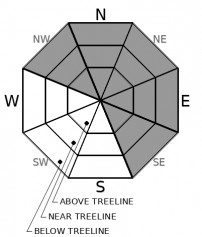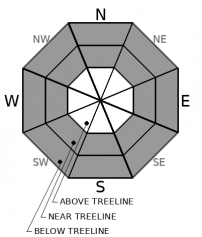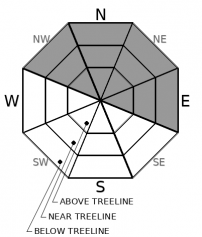| Thursday | Thursday Night | Friday | |
|---|---|---|---|
| Weather: | Cloudy. Widespread snow showers. Snow levels below 7000 feet. Chance of precipitation is 100%. | Cloudy. Widespread snow showers in the evening, then chance of snow showers after midnight. Snow levels below 7000 feet. Chance of precipitation is 90%. | Mostly cloudy. Chance of snow through the day. Snow levels below 7000 feet. Chance of precipitation is 30%. |
| Temperatures: | 27 to 32 deg. F. | 18 to 24 deg. F. | 32 to 37 deg. F. |
| Mid Slope Winds: | Southwest 20 to 35 mph with gusts to 60 mph. | Southwest 15 to 30 mph. Gusts up to 45 mph. | Southwest 10 to 15 mph with gusts to 25 mph in the morning becoming light. |
| Expected snowfall: | 80% probability of 12 to 20 inches. 20% probability of 20 to 30 inches. | SWE = 0.90-1.35 inches. | 80% probability of 3 to 7 inches. 20% probability of 7 to 12 inches. | SWE = up to 0.40 inch. | 100% probability up to 1 inch. | SWE = less than 0.10 inch. |
| Thursday | Thursday Night | Friday | |
|---|---|---|---|
| Weather: | Cloudy. Widespread snow showers. Snow levels below 7000 feet. Chance of precipitation is 100%. | Cloudy. Widespread snow showers in the evening, then chance of snow showers after midnight. Snow levels below 7000 feet. Chance of precipitation is 85%. | Mostly cloudy. Chance of snow through the day. Snow levels below 7000 feet. Chance of precipitation is 30%. |
| Temperatures: | 22 to 28 deg. F. | 16 to 21 deg. F. | 28 to 34 deg. F. |
| Ridge Top Winds: | Southwest 40 to 60 mph with gusts to 130 mph. | Southwest 30 to 50 mph with gusts to 100 mph. | West 30 to 45 mph with gusts to 80 mph. |
| Expected snowfall: | 80% probability of 15 to 24 inches. 20% probability of 22 to 32 inches. | SWE = 1.00-1.50 inches. | 80% probability of 3 to 7 inches. 20% probability of 7 to 12 inches. | SWE = 0.25-0.50 inch. | 100% probability up to 1 inch. | SWE = less than 0.10 inch. |




























